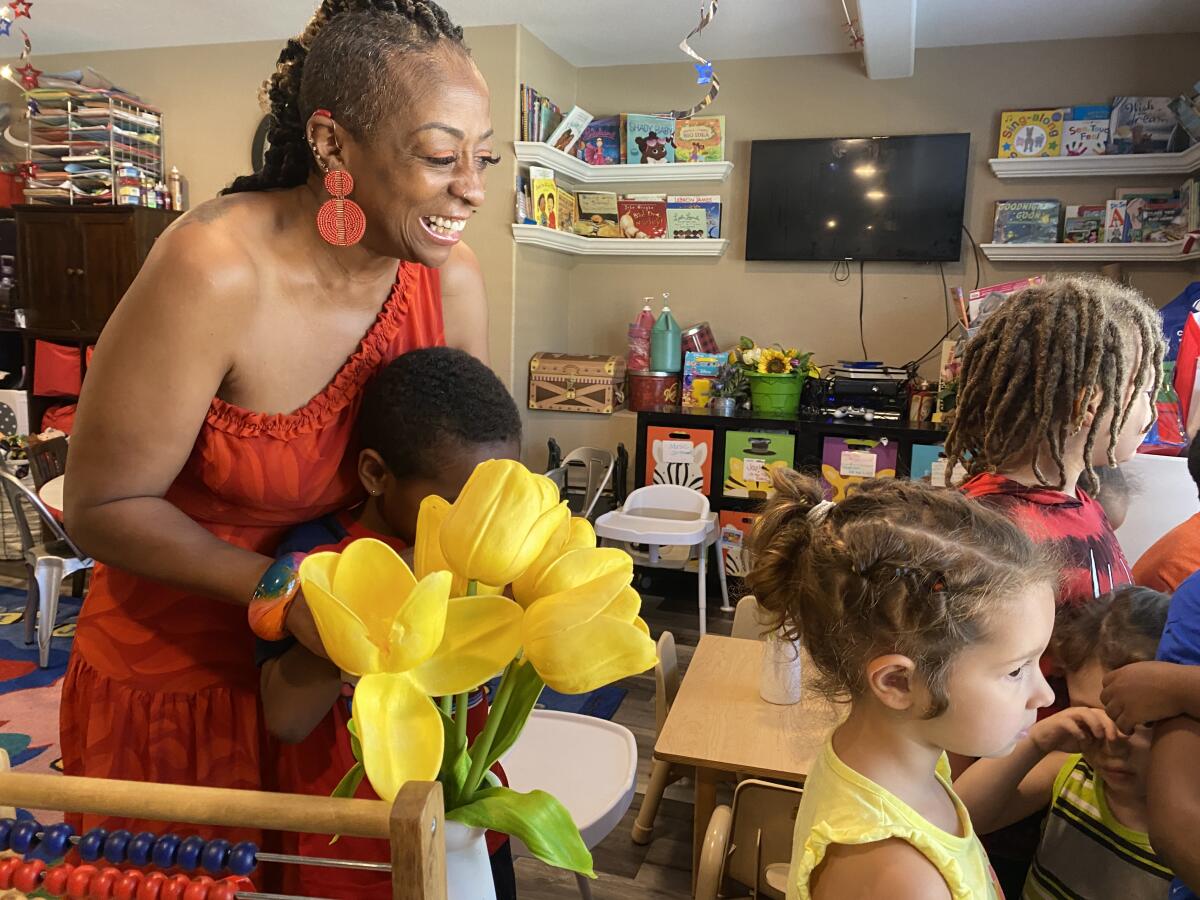California child-care providers fight to ‘retire with dignity’

- Share via
SACRAMENTO — Renee Kuykendall woke up at 4 a.m. to prepare for the arrival of her first client. She won’t be done with her last client of the day until 11 p.m.
In her home in Antelope, just outside Sacramento, she makes enough eggs, sausage, grits and toast for 13 people, to be served at 7 a.m. She checks on the frogs in the fish tank — a crowd favorite — and makes sure her house is spotless; she’s recently had a problem with boogers smeared on the walls.
Kuykendall, 60, has operated a day-care business out of her home for nearly 20 years. When the long workdays become too hard, she will be able to stop and still be financially sound, thanks to retirement savings from a prior career with the federal government.
But she worries for many of her peers, who say that, after years of earning low wages and with no retirement benefits available, they won’t have any savings when their working days are over.
More than a year after newly unionized child-care providers in California signed their first-ever contract with the state, a push to “retire with dignity” has moved to the top of the 40,000-member organization’s priority list.
“It’s not right that everybody else gets these things and we don’t,” Kuykendall said over a chorus of children sounding out words on flash cards. “It goes back to ‘babysitters’ versus child-care providers. I am a business owner. I’m amazed at how ignorant people are as to what we do, and we have their most prized possession.”
The state budget signed by Gov. Gavin Newsom in June includes funding for a study regarding potential retirement benefits for child-care providers who offer state-subsidized care out of their homes. What those benefits would actually look like, and cost, is unknown and will have to be negotiated between state and union leaders — complex bargaining that could last years.
In the meantime, people like Renaldo Sanders are feeling nervous about the future. Sanders, 69, has worked as a licensed child-care provider in Compton since 1993. Some of the children she looks after now are the third generation that she’s cared for from the same family.
One in 5 home-based family child-care providers in California are 60 or older, according to a survey conducted by UC Berkeley’s Center for the Study of Child Care Employment in 2020.
“The babies are getting heavier,” Sanders said, noting the physicality of the job as she ages. “But I don’t have any physical limitations, knock on wood, praise God.”
Sanders has no plans to retire any time soon. Her financial backup plan is to sell her home.
“I did not put away funds because I didn’t have funds available. There weren’t any extra funds to put away,” she said. “There are emergencies. There would always be something else that would come up that I would have to take care of.”
Just 21% of California workers operating home-based day cares reported having some form of retirement savings, according to the center. Comparatively, 46% of Californians working in the private sector have a retirement plan, according to a report by the UC Berkeley Labor Center.
Nationally, workers with lower incomes are less likely to have access to retirement benefits.
If Child Care Providers United is successful in securing a retirement vehicle for California’s home-based child-care workers — an industry dominated by women of color — it would be the first setup of its kind in the U.S.
California offers CalSavers, a low-cost, state-sponsored individual retirement account, to workers whose employers do not offer a retirement plan. But the program, which has been challenged in court, has limits, including a cap on contributions of $6,000 to $7,000 a year, depending on a participant’s age.
That’s not the long-term solution that the union is looking for, said Alexa Frankenberg, executive director of Child Care Providers United.
“It’s all about choice. People choose to work until they’re 80, and that’s great. But they shouldn’t be forced to do it,” she said. “People are doing this because there’s no other way for them to support themselves and their families after working in this field for decades, and that’s what we’ve got to address.”
Since Newsom signed into law in 2019 the right for child-care providers to collectively bargain — a decade-plus effort vetoed by past governors — the state has increased rates, secured “start-up funding” for healthcare benefits and issued checks up to $10,000 in COVID-19 supplemental pay, as day cares remained open during school closures.
Frankenberg, who praised Newsom for his focus on early childhood, said the state has a long way to go, especially when it comes to pay.
In 2019, the median hourly wage for child-care workers in California was $13.41, according to the Center for the Study of Child Care Employment.
Home-based providers are self-employed but receive state funding, as they offer subsidized child care to income-eligible families. Take-home pay varies depending on how much of what the state offers has to be spent on operating costs, which can include food, supplies and water and electricity bills.
Annette Nicholson, 62, recently paid more than $600 to replace a piece of fencing surrounding her home in Stockton so that the children she cares for would have a safe, closed-in yard to play in. She said that her take-home pay after expenses is about $15,000 a year, and that the unexpected cost ate into her savings.
“A lot of us are getting near retirement, and we’re all nervous and scared,” she said. “There’s an age that I hope I can stop, but financially, I don’t know if I’m going to be able to do that.”
Camille Travis, a spokesperson for the California Department of Human Resources, said the state supports the idea of retirement benefits for providers but has not agreed on parameters with the union or what the state’s involvement would be.
“Obviously we’re committed to figuring out what that looks like,” she said. “This is a first step.”
State Sen. Brian Dahle (R-Bieber) voted against the legislation that allowed child-care workers to unionize, and said he worries the cost to the state will become too much, especially amid talk of a recession.
He pointed to state budget battles over benefits for in-home supportive workers who care for low-income elderly and disabled Californians. Since unionizing in 2015, those caregivers have secured paid sick leave and overtime, increasing costs to the state.
“On the surface, it’s awesome, but it turns into another whole bureaucracy of government,” said Dahle, who is running against Newsom for governor in November. “Where we’re headed, they’re going to keep driving the costs through the roof, and that comes out of the taxpayer-funded general fund.”
Beyond the details of negotiations, the push for basic benefits comes down to a debate about respect for the child-care industry that’s rooted in racism and sexism, said Dion Aroner, a former Democratic state legislator from the San Francisco Bay Area who first tried to unionize child-care workers in 2003.
“This is about the undervaluing of services that these women of color provide based in a system that goes back 400 years, when Black women took care of white babies when they were in slavery,” she said. “I don’t want to say nothing has changed, because that’s not fair, but the basics of who is doing the care, and the blatant lack of respect, hasn’t changed.”
More to Read
Sign up for Essential California
The most important California stories and recommendations in your inbox every morning.
You may occasionally receive promotional content from the Los Angeles Times.











